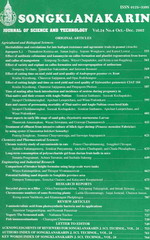ThaiScience
ThaiScience
SONGKLANAKARIN JOURNAL OF SCIENCE & TECHNOLOGY
Volume 42, No. 04, Month JULY, Year 2020, Pages 788 - 794
Biodegradability of single and mixed surfactant formulations
Jarrent R. Tayag and Ronaldo M. Fabicon
Abstract Download PDF
Even though detergent surfactants are mandated to be biodegradable, the environmental fate of these surfactants when mixed together in bodies of water is still not established. The study aimed to determine the biodegradability of NaLAS/CTAB surfactant combinations by measuring the amount of evolved CO2 which was measured using the OECD 301b procedure. The 90/10 and 10/90 NaLAS/CTAB systems showed a decline in biodegradation behaviors which were recorded as 55.88% and 40.12% biodegradation, respectively, after a 28-day monitoring period. Conductivity results revealed changes in the availability of ions in the system. An inflection point was observed at a CTAB concentration of 700 ppm. The highest turbidity was noted at a NaLAS/CTAB molar ratio of 1.39:1 which indicated the formation of insoluble catanionic salts in the system. Conductivity and turbidity testing revealed the formation of anionic-cationic structures such as micelles and ion-ion complexes. These structures may alter the natural degradation mechanism of microorganisms, thus leading to the slower rate of biodegradation or incomplete degradation of the surfactants.
Keywords
surfactant biodegradation, surfactant combinations, waste water treatmentSONGKLANAKARIN JOURNAL OF SCIENCE & TECHNOLOGY
Published by : Prince of Songkla University
Contributions welcome at : http://rdo.psu.ac.th
